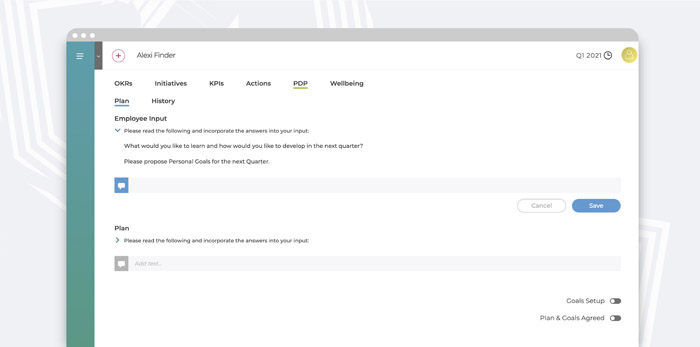The Essential Guide To OKR Management

Objectives and Key Results (OKR) are fast becoming the default goal setting frameworks for companies that want to share company strategy and objectives and have teams and employees align their goals with them.
The ability of Objectives and Key Results to direct and empower employees to align goals with strategy, as opposed to having their goals handed down to them, is behind the growth in popularity of OKR. It’s how employees want to be managed.
With the pace of change accelerating the short planning cycles and the need for organisations of all sizes to have a more engaged, autonomous workforce capable of increasing their agility is another reason for the framework being appropriate for the world we live in today. Not to mention the wanting higher levels of talent retention.
The Need For OKR Management
OKR management is the process whereby an organisation, teams and employees debate, create, monitor, and adapt to changes in Objective and Key Result progress in a continuous way, as part of a more general performance management program.
Gone are the days of ‘set and forget’ annual goals. Shorter quarterly goal planning cycles are now the norm and there are OKR management cadences that align with these that are important to understand and adopt if you’re going to succeed with OKR.
OKR management means having annual and quarterly retrospective and planning meetings in your teams, with your manager as part of your performance management processes, and across teams in order for goals to be horizontally aligned.
As part of these retrospective and planning meetings OKR can either be continued and have Key Result success recalibrated, or new Objectives and Key Results can be created. The reality is that for most it is a mixture of both.
Being able to define, share, track OKR and discuss progress, plans and problems at a regular cadence, both independently and in teams is another key component of making OKR part of your wider drive for agility and better performance management. For most this means having team check-ins that are more executional or operationally focused weekly, and full OKR reviews monthly.
Meetings require OKR to be part of these meetings agendas, so having an agreed meeting cadence and getting these meetings in diaries and committed to is essential. Something you can use OKR software like ZOKRI to streamline.
Commit to OKR Management Across The Business
With transparency being both essential to alignment and something that employees find motivating and useful, it’s important that the OKR management process is not applied in silos, and is not used by some teams and not others, even if some teams by their very nature are more OKR centric than Business-as-Usual where processes and jobs-to-be-done maintain what is good or good enough.
OKRs should be part of weekly team meetings if you have them. You can also include them in town halls and regular email communications, and they are central to all strategy and goal setting conversations.
OKR Management Is Part Of Performance Management
Performance Management is a set of processes that facilitate two-way open communications on how an organisation’s objectives can be achieved in a way that aligns with the needs of the employees. OKRs are naturally a key part of your Performance Management plans.
You will want OKRs to be part of how team and individual employee performance is both defined, managed and evaluated. But you will of course need to ensure that OKR progress is part of a performance story, not the whole story.
It’s important to move towards assessing an individual’s contribution based on a wider set of inputs, including a bias towards a team’s performance, an appreciation for what is good and maintained – not just of strategically important, how employees behave as part of that team in the context of desired values and behaviours, and how they are learning and developing. There is also a general consensus that OKR and remuneration conversations should be detached.
OKR Management Needs Access To Metrics
If you’re going to create and manage OKRs on a continual basis then at the heart of the process is measurement and metrics (KPIs). Some of the most important conversations that your teams will have is around the ‘as measured by’ component of a Key Result. Good Key Results have good metrics and hard targets as a general rule. What holds a lot of teams back is not having access or even a process of getting access to metrics or ‘measurements that matter’.
We would suggest making Health Metric / KPI conversations at all levels of your organisation part of the OKR management process. Agree what success looks like for KPIs. Agree what needs to be improved and what can be maintained. Focus your efforts on what will help you achieve your objectives. Make the continual monitoring of KPIs part of what OKR management means to you.
Teams without metrics (KPIs) often default to creating activity based Key Results because this is all they can measure. Embracing OKR means embracing measurement and measuring the impact of our hard work, not making hard work the goal.
OKR Management Needs Great Software
If you’re looking to adopt OKRs and embed the management processes that ensure that the framework thrives, you’re going to need OKR software like ZOKRI. Everything you’re going to want and need is available is a comprehensive goal and performance management platform.
Start An OKR Pilot
And Share Your Experience With Other Teams
If you’re totally new to OKRs you can start with OKR Pilot – perhaps just in one team:
- Share this OKR guide amongst your team so you’ve had the same introduction
- Create one to three high priority 90-day goals with hard to achieve measurable outcomes
- Brainstorm for Initiatives to achieve this goal and move ahead with the best ones
- Commit to weekly check-in and discussion
- Sign-up to ZOKRI – it’s free for the pilot and there’s lots of exclusive eduction in the platform itself
- Go through the OKR education and platform on-boarding videos
- Add your Mission, Visions, Purpose and Strategy if you have it – don’t worry if you don’t – can be turned-off
- Connect tools like Jira, Spreadsheets, Google Analytics … to automate some of your KPIs and Initiatives
- Create Manually updates KPIs and get reminders and workflows to update them
- Choose your check-in cadence – most people choose weekly
- Manage your OKRs in ZOKRI, get check-ins reminders, share problems and much more
- Present your findings and experiences at the end of the Quarter
- United Kingdom
Ashtead
KT21 1RZ
+44 20 7046 1328

- United States
New York
NY 10013
+1 646-718-4720
- ZOKRI helps leaders and teams achieve strategic goals using the OKR (Objectives & Key Results) framework. Our platform aligns strategy, goals, and people, fostering engagement and growth through comprehensive training and management systems.
© ZOKRI 2025 All rights reserved | Privacy Policy | Terms & Conditions | GDPR
Contacts Us
Tell us what you need. We'd be delighted to help.
"*" indicates required fields
